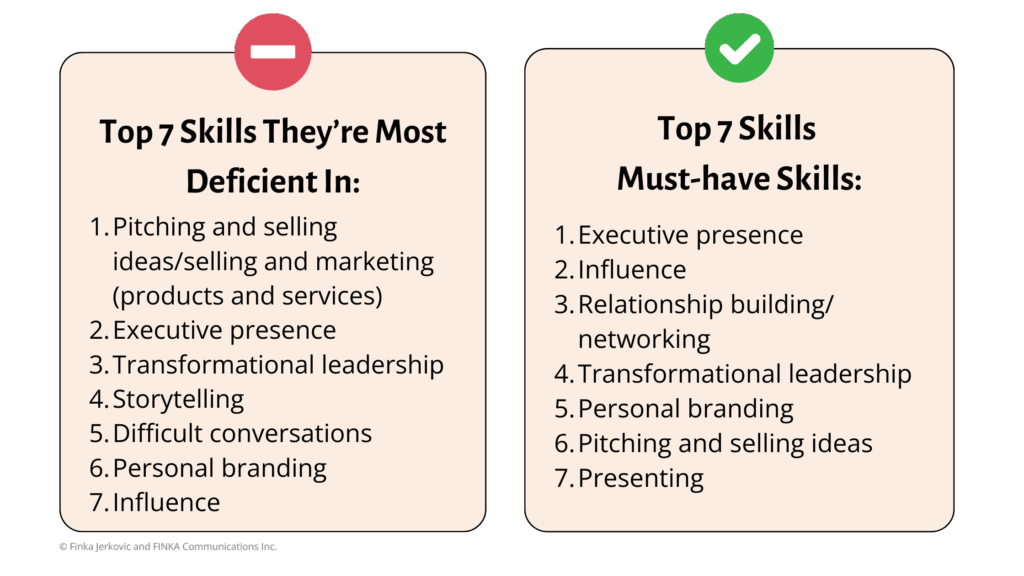There’s a key leadership skill that’s being overlooked and underhyped. One that plays a pivotal role in career advancement. And that is storytelling. Executive presence means you have a strong ability to captivate and engage people, while stories foster connections and empathy, so it only makes sense that executive presence and storytelling go hand in hand… Yet people aren’t leveraging them. It’s time to understand how to develop executive presence through storytelling and why you can’t afford to count this skill out.
Download Your Executive Presence Story Bank
Collect and master your stories to captivate and engage your audience.

Storytelling: A Missed Opportunity
Last year, I surveyed 100+ corporate professionals and leaders (mainly in the financial services, consumer goods, and insurance industries), developing a Career Advancement Forecast.
The goal of my research was to not only inform corporate leaders of the skills they need to advance in 2025, but how managers can best support their people into the future.
Interestingly, when asked to rank leadership skills that they felt were required for career advancement, storytelling landed in the middle of the pack.
As you can see below, it didn’t make it on to the top seven must-have skills list, but it did for the top seven skills people were most deficient in.

But don’t worry because I’m about to clear the air with the importance and power of stories and how you can become a strategic storyteller to strengthen your leadership and executive presence.
Why Storytelling?
Storytelling is seen as nice-to-have but it’s a must if you want to grow in your leadership and career. Here’s why:
- Stories make messages sticky and memorable.
- Storytelling enables effective and empathetic communication.
So, if you don’t want to be forgotten or you want people to clearly understand and latch onto your messages and ideas, you need storytelling (stories are 22x more memorable than facts alone).
How to Tell a Story: 4 Types
Now’s the perfect time to have your Executive Presence Story Bank handy. Fill it out as you learn about the types of stories to tell at work.
Type 1: Who Are You?
Use these types of stories to define moments you’ve had in your career or in your personal life that have created who you are. Share these with others to help them understand and connect with you.
For instance, I have a “name” story. Some people know me as Josie, while others know me as Finka. Essentially, I thought I had to compartmentalize myself throughout my life as Josie the ambitious corporate leader and banker, and Finka as the caring and devoted mom, friend, and micro-farmer.
Plot twist, I didn’t need to do this, but I often leverage this story to remind people they don’t need to contort themselves to succeed. You can read the full story here.
Type 2: Why Are You Here?
Use these stories to add relevancy, letting people know what you care about and why those themes are important to you.
For example, when I was in my early corporate days, I felt like an underdog and felt for the fellow underdogs in the room, who were, at that time, introverts. So, I decided I was going to make a whole program titled “The Daring Introvert,” which was my way of helping quieter voices in the room. I wanted them to be heard because I knew they had amazing ideas but didn’t have the courage to share their solutions. I weaved in this story and purpose into my pitch, and the program was executed.
Type 3: Lessons You’ve Learned
While they aren’t easy to share, this is where you disclose your mistakes and what you’ve learned from them. Failure stories often have success stories attached to them. This builds trust through vulnerability and transparency, increasing the know, like, trust factor.
Type 4: Impact
These are stories about other people or projects you’ve worked with. They illustrate the impact you’ve created, but you’re not really showcasing what you’ve done. You’re showcasing other people and projects and the outcomes. You’re putting other people on a pedestal to show how they were able to overcome a hardship or achieve success in a project.
Which Story Will You Tell?
It will depend on your scenario.
- To create connection and understanding: Who Are You?
- To generate relevancy and purpose: Why Are You Here?
- To increase the know, like, trust factor: Lessons You’ve Learned.
- To illustrate experience: Impact.
Own your distinct plots and know which stories to leverage every time by writing them all down in your Executive Presence Story Bank.


